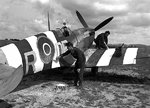I've decided to bypass the decals and go for hand-painted invasion stripes on my TBolt for the GB. Halfway in I'm beginning to regret my decision  I think the wings are going to be okay but I'm stumped on the fuselage.
I think the wings are going to be okay but I'm stumped on the fuselage.
I'm sure someone has done this with some success. What's the best way to paint the invasion stripes on the fuselage?
Also, I've found conflicting info in my research. I've seen articles that say the stripes were handpainted, some say they were sprayed? Is it one, is it both...any help is appreciated?
Thanks.
I'm sure someone has done this with some success. What's the best way to paint the invasion stripes on the fuselage?
Also, I've found conflicting info in my research. I've seen articles that say the stripes were handpainted, some say they were sprayed? Is it one, is it both...any help is appreciated?
Thanks.

